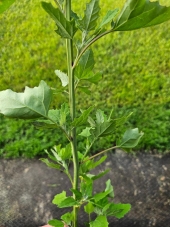




 2
2




homesteadpaul




 1
1




The ultimate goal of farming is not the growing of crops, but the cultivation and perfection of human beings. - Masanobu Fukuoka





.





Paul Cereghino- Ecosystem Guild
Maritime Temperate Coniferous Rainforest - Mild Wet Winter, Dry Summer








Sometimes the answer is not to cross an old bridge, nor to burn it, but to build a better bridge.

























 2
2









Works at a residential alternative high school in the Himalayas SECMOL.org . "Back home" is Cape Cod, E Coast USA.




For unlimited return on all your investments - Make your deposits at 'The Entangled Bank' !




Rebecca Norman wrote:We've got plenty of lambsquarters as a weed in our gardens here, and we collected and ate a lot in the springtime. At some point we quit eating it and started giving it to the cows instead, pulled up with its roots. But can somebody tell me if it's worth pulling off and eating the big leaves even in mid summer?
Some people around here dry it for the winter -- I'm not sure if they do that with the tender spring plants or big summer leaves. One person told me they pick the leaves, mash them in the mortar and pestle, and shape them in to round flat cakes that they dry for more convenient use.
"We're all just walking each other home." -Ram Dass
"Be a lamp, or a lifeboat, or a ladder."-Rumi
"It's all one song!" -Neil Young




trying to turn my thumb green





For unlimited return on all your investments - Make your deposits at 'The Entangled Bank' !
 1
1




Matt mcmenaman wrote:Anyone know if the seeds are good for human or chicken consumption? I'm always looking for alternative grains. BTW this is the first summer I was confident to ID lambsquarter and harvest some for eating. I read that cooking the greens renders the oxalic acid harmless. We sauteed it like spinach (garlic and oil) and served it to the whole family. Everyone liked it but the teenagers were weirded out by eating weeds-LOL! I didn't tell them until afterwards (cue evil laugh here)
"You may never know what results come of your action, but if you do nothing there will be no result”
How Permies.com Works
Be Nice
 1
1




My project thread: http://www.permies.com/t/20399/projects/Maine-Master-Plan




Hardiness Zone 6 Save the bees.




David Smolinski wrote:I need to know an efficient way to eat it. Are the buds edible? It was time consuming to pick the leaves and not the buds. I steamed it a little.
"We're all just walking each other home." -Ram Dass
"Be a lamp, or a lifeboat, or a ladder."-Rumi
"It's all one song!" -Neil Young




![Filename: KIMG0102.jpg
Description: [Thumbnail for KIMG0102.jpg]](/t/6415/a/54858/KIMG0102.jpg)
Hardiness Zone 6 Save the bees.




David Smolinski wrote:Too time consuming to separate leaves and buds
"We're all just walking each other home." -Ram Dass
"Be a lamp, or a lifeboat, or a ladder."-Rumi
"It's all one song!" -Neil Young









"We're all just walking each other home." -Ram Dass
"Be a lamp, or a lifeboat, or a ladder."-Rumi
"It's all one song!" -Neil Young




Deb Rebel wrote:In bud/seed... taken a few days ago.
"We're all just walking each other home." -Ram Dass
"Be a lamp, or a lifeboat, or a ladder."-Rumi
"It's all one song!" -Neil Young




Hardiness Zone 6 Save the bees.




David Smolinski wrote:I'm going to take the risk and eat buds. I would like advice for conserving seed and maximizing next year's crop.
"We're all just walking each other home." -Ram Dass
"Be a lamp, or a lifeboat, or a ladder."-Rumi
"It's all one song!" -Neil Young








William Bronson wrote: I've never seen this plant in my yards with anything but small leaves.
When we have harvested them, it takes a long time to gather a handful of uncooked leaves.
When I eat greens I eat the stems as well as the leaves,cutting them small and cookinging them thoroughly.
Is this a palatable choice with Lambs Quarters?
"We're all just walking each other home." -Ram Dass
"Be a lamp, or a lifeboat, or a ladder."-Rumi
"It's all one song!" -Neil Young




Hardiness Zone 6 Save the bees.




David Smolinski wrote:The buds tasted horrible. Pick the leaves and buds, and sift out most buds. This did ok as a summer cover crop. I should have used Sudan grass.
"We're all just walking each other home." -Ram Dass
"Be a lamp, or a lifeboat, or a ladder."-Rumi
"It's all one song!" -Neil Young
 1
1









![Filename: lambsquarters.gif
Description: Lambsquarters nutritional analysis [Thumbnail for lambsquarters.gif]](/t/6415/a/59290/lambsquarters.gif)





 4
4




Innovations that are guided by smallholder farmers, adapted to local circumstances, and sustainable for the economy and environment will be necessary to ensure food security in the future. Bill Gates

| I agree. Here's the link: http://stoves2.com |






